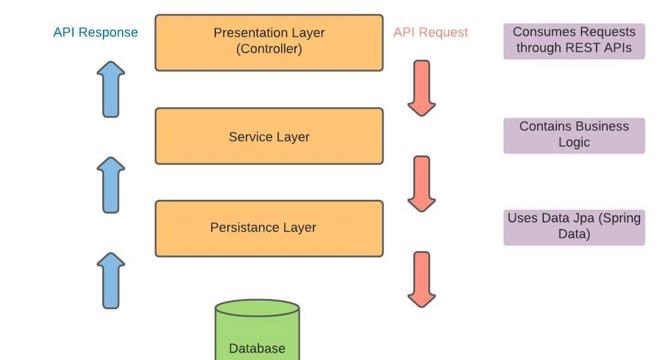React
Dev
274

Image Credit: Dev
React Testing Setup: Vitest + TypeScript + React Testing Library
- Setting up a React app using Vite and TypeScript with Vitest and React Testing Library can be a bit tedious initially.
- Steps include creating a new React + TypeScript project, adding Vitest, enabling global test functions, and adding React Testing Library.
- Additional steps for fixing assertion errors and testing user events are provided in the guide.
- The final summary includes commands for installing required packages and necessary updates for vite.config.ts, tsconfig.app.json, and src/tests/setup.ts.
Read Full Article
16 Likes
Javarevisited
305

Image Credit: Javarevisited
Student Management System Project - FullStack Java + Spring Boot + React.js Example Tutorial
- Learn to create a School Classroom Application using Spring Boot, React.js, and H2 Database.
- The project involves functionalities like creating, deleting, updating, and retrieving student data.
- Frontend is built using React.js, backend using Spring Boot, and communication is through REST APIs.
- This tutorial guides on full-stack Java development for those who wish to become full-stack Java developers.
Read Full Article
18 Likes
Dev
348

Image Credit: Dev
This Week In React #237: RSC, TanStack, Storybook | Legacy Arch, Hermes N-API | TC39, Import Maps, Vite, Vitest...
- React community has been active with multiple releases and updates, including RSC blog posts by Dan Abramov, Storybook integration with Vitest and Playwright, and the unveiling of plans to freeze the Legacy Architecture by the React Native team.
- The TC39 meeting saw progress on 3 proposals to stage 4, while Vite ecosystem made various announcements.
- Storybook 9 release offers new features such as interaction, accessibility, and visual tests, along with leaner installation and tag-based organization.
- Various updates from TanStack, including documentation migration, CVE fixes, and upcoming events like React Advanced London.
- Different articles by Dan Abramov cover topics like data streaming strategies, React data fetching patterns, and insights into RSC and bundlers.
- Exciting releases include Lingo Compiler for automatic translation, LiveStore for state management, and Base UI 1.0 Beta.
- Updates from React-Native include plans to freeze the Legacy Architecture, Hermes PR acceptance, and support for 120fps on iOS.
- Other developments include TC39 advances, resilient import maps, and updates on Vite, Vitest, and Babel.
Read Full Article
20 Likes
Dev
283

Image Credit: Dev
This Week In React #236 : Remix, TanStack, RSC | ExecuTorch, Screens, FlashList, Reanimated, Expo, EAS, Radon...
- Remix announced big news with Microsoft making it easier to try out TypeScript Go rewriting.
- React Native saw minor releases, with the App.js config starting soon.
- Remix v3 plan includes using Preact for a new framework, aiming to reimagine web frameworks.
- Articles cover topics like TanStack Router features, server and client component composition, React meta-frameworks, SolidJS, and more.
- Next.js 15 and React 19 developments, Docusaurus 3.8, Storybook 9.0, TanStack Query v5.77 updates were highlighted.
- React-Native updates include EAS Workflows, Expo changes, RN ExecuTorch 0.4.0, RN Screens 4.11, Radon IDE 1.7, Reanimated 4.0.0-beta.4.
- Microsoft announced TypeScript Go rewrite previews, msw creator's advice on testing, ESLint v9 retrospective, and more in the Other section.
- Firefox 139 introduced Temporal API support, JSPM 4.0 for import map package management, and Angular 20.0 updates in package management.
- Various articles covering JavaScript history, tool transitions, and browser updates were mentioned.
- Overall, the week in React brought significant developments and insights across frameworks, tools, and platforms.
- Subscribe to the newsletter for weekly updates and stay informed about the latest in the React ecosystem.
Read Full Article
17 Likes
Discover more
Dev
371

Image Credit: Dev
10 Common React Mistakes New Developers Make (and How to Fix Them)
- Not using URL query parameters can lead to issues like page refresh resetting filters and inability to share filtered views.
- Avoiding the
- Having too many independent useState calls can make it challenging to manage and update as the form grows.
- Not using derived state can result in duplicated state leading to stale or incorrect values.
- Misusing useMemo by running it unnecessarily on every render can be inefficient.
- Neglecting loading, error, or empty states can result in poor user feedback and SEO issues.
- Ignoring accessibility best practices like using
Read Full Article
22 Likes
Dev
397

Image Credit: Dev
Nx Monorepo Guide: React & Node Fullstack App
- A monorepo consolidates code for multiple projects in one version control repository, simplifying shared code distribution and speeding up development.
- Nx is a smart monorepo tool designed for managing JavaScript and TypeScript projects efficiently.
- Nx offers features like project structure understanding, time-saving computation caching, code generators, clean testing setup, and support for popular frameworks.
- Comparing Nx to other tools like Lerna and Turborepo showcases Nx's comprehensive approach and active maintenance.
- Nx workspace setup involves using CLI commands like create-nx-workspace to initiate a powerful development environment.
- Essential Nx configuration files like nx.json, package.json, and tsconfig files play crucial roles in defining project structures and settings.
- Nx CLI commands such as generate, serve, build, test, lint, graph, and affected facilitate efficient workspace management.
- Creating Node.js backend apps and React components within an Nx monorepo is streamlined, promoting code reuse and clean architecture.
- Nx's hot reloading and development workflow, along with its dependency graph visualization, ensure fast feedback loops and efficient builds.
- Enforcing module boundaries and import restrictions, managing dependencies centrally, and understanding app vs. library usage are key concepts in Nx workspace architecture.
Read Full Article
23 Likes
Javacodegeeks
240

Image Credit: Javacodegeeks
Build an AI Chatbot in React with LangChain.js and OpenAI
- Learn how to create a dynamic AI chatbot using React, LangChain.js, and OpenAI with streaming responses, memory management, and action plugins.
- Set up your React application by initializing a project with Vite and installing LangChain.js and OpenAI dependencies.
- Configure your OpenAI API key in a .env file and understand the chatbot architecture flow between React frontend, LangChain.js logic layer, OpenAI, and external APIs.
- Implement chat memory using LangChain's RunnableWithMessageHistory and enhance chatbot capabilities with action plugins like fetching weather information.
Read Full Article
14 Likes
Logrocket
350

Image Credit: Logrocket
React forwardRef explained: Usage, alternatives, and React 19 update
- forwardRef is a React utility that lets a parent component pass a ref through a child component to access the child’s DOM node or instance directly.
- It enables direct interaction between parent and child components, especially when dealing with higher-order components or wrapper components.
- Refs in React allow access and interaction with DOM elements directly, bypassing typical data flow and enabling actions beyond props and state.
- Common use cases for refs include managing focus, text selection, media playback, triggering animations, integration with third-party DOM libraries, and measuring element dimensions.
- While powerful, refs should be used sparingly to maintain code clarity and readability, favoring props and state for data flow.
- Creating and attaching refs in class components involves using createRef to create a ref and associating it with a DOM element for direct manipulation.
- In functional components, refs cannot be attached directly, but forwardRef allows for ref forwarding, enabling parent components to interact with child components' DOM elements.
- useImperativeHandle works with forwardRef to customize instance values exposed when using refs, providing more control and functionality.
- Refs should not be used unnecessarily in React, especially for unnecessary DOM manipulation, accessing internal states of child components, or replacing controlled components.
- Choose between forwardRef, useRef, callback refs, React Context, and useImperativeHandle based on the component hierarchy and the need for direct DOM access.
Read Full Article
21 Likes
Logrocket
223

Image Credit: Logrocket
How to use the useEffect hook in React: A complete guide
- useEffect enables handling side effects directly inside functional components in React, from data fetching to DOM manipulation.
- This guide aims to clarify the core concepts behind useEffect, covering real-world lessons and effective usage patterns.
- Basic usage of useEffect involves running code once when the component mounts: useEffect(() => { // Code to run once }, []);
- useEffect in React is for handling effects like fetching data or DOM manipulation and differs significantly from class-based lifecycle methods.
- Understanding basic JavaScript concepts is crucial when using useEffect to avoid problems with outdated props or state values.
- Key points include defining effects clearly, controlling dependencies, adding cleanup logic, avoiding unnecessary effects, and keeping effects efficient.
- useEffect is commonly used for asynchronous tasks like data fetching, allowing components to manage actions after mounting.
- Effects run after rendering and update in React, providing asynchronous behavior without blocking the UI.
- Advice for seasoned React developers includes transitioning from class-based components to functional components with Hooks.
- The control flow of effects in React includes initial render/mounting, subsequent renders, cleanup function execution, and unmounting.
Read Full Article
13 Likes
Dev
311

Image Credit: Dev
🚀 Top 6 PDF Viewers for React.js Developers in 2025
- When working with React.js, displaying PDFs can range from simple to complex, depending on needs.
- Selecting a PDF viewer depends on factors like project requirements, ease of integration, and customization options.
- Open source options like PDF.js and react-pdf offer basic PDF rendering and easy integration for small to mid-sized applications.
- Paid options like React PDF and React PDF Viewer provide more functionalities tailored for React projects, including customization and advanced features.
- Hybrid options like PDF.js Express and Syncfusion React PDF Viewer offer a mix of free and paid features for scalable PDF capabilities.
- Consider factors like React integration, feature strengths, and limitations when choosing a PDF viewer for your project.
- Always review documentation and support to ensure the selected library aligns with your project's scope, future needs, and budget.
- React PDF is recommended for its flexible, powerful features suitable for various React.js applications.
- Different libraries cater to different needs, with open source options being budget-friendly and paid options offering more advanced features.
- It's essential to assess each library's strengths, weaknesses, and compatibility with your project before making a decision.
Read Full Article
18 Likes
Javacodegeeks
325

Image Credit: Javacodegeeks
Integrating AI Autocomplete in React with OpenAI
- Integrating AI Autocomplete in React with OpenAI has become simple with the latest evolution.
- OpenAI's language models offer dynamic suggestions beyond traditional autocomplete methods.
- The guide covers setting up a React component for real-time autocomplete with efficient state management.
- A React app is scaffolded and an AutocompleteInput component is created to handle user input.
- A backend server using Express is set up to proxy OpenAI requests, ensuring security by not exposing API keys.
- User input is sent to the backend, which communicates with OpenAI to fetch autocomplete suggestions, creating a seamless flow.
- Real-time suggestions, debounce API calls, UX enhancements, and future integration possibilities are also discussed in the article.
- The combination of OpenAI intelligence with React interactivity allows for building advanced autocomplete systems.
- Cost, usage quotas, and optimization strategies are mentioned to effectively manage AI autocomplete implementation.
- The article provides references, useful links, and encourages readers to explore further development possibilities.
Read Full Article
19 Likes
Arxiv
258

Image Credit: Arxiv
React to Surprises: Stable-by-Design Neural Feedback Control and the Youla-REN
- Researchers propose a structure for stabilizing nonlinear policies for learning-based control using a combination of Youla-Kucera parameterization and robust neural networks like recurrent equilibrium network (REN).
- The parameterizations introduced are unconstrained, enabling optimization with first-order methods while ensuring closed-loop stability.
- The study examines nonlinear dynamics, partial observation, and incremental closed-loop stability requirements, finding that a contracting and Lipschitz Youla parameter leads to closed loops with similar properties.
- Numerical experiments demonstrate the effectiveness of the proposed parameterization in learning controllers with stability guarantees for scenarios like economic rewards, short training horizons, and uncertain systems.
Read Full Article
15 Likes
TheNewsCrypto
320

Qubetics Presale Volume Gains Put It Among the Best Crypto To Buy Now While BNB and Theta React to Trend Shift
- Bitcoin's 24-hour trading volume has surged, signaling a potential breakout quarter in the crypto market. Solana and Ethereum have shown positive trends, with analysts foreseeing a parabolic rally through 2025.
- Qubetics ($TICS) is gaining attention for addressing international payment inefficiencies, particularly in cross-border transactions, catering to institutional demand for cost-effective solutions.
- Qubetics leverages the $TICS token for near real-time fund transfers, enhancing transparency and speed in global money movement, offering real-world utility and unique value in the market.
- The Qubetics presale has reached Stage 37, attracting over $17.6 million in investments, featuring weekly 10% price increases, and offering substantial projected returns for early participants.
- Theta and BNB, while showing different performance metrics, reflect the high activity in the current crypto market, with Theta facing short-term volatility and BNB surging in DeFi metrics and institutional activity.
- BNB's strong technical performance and institutional engagement, including ETF filings and regulatory clarity, position it as a dominant token by volume and sentiment in the market.
- The crypto market's bullish acceleration, led by Bitcoin's trading volume spike, is influencing altcoins like Solana and Ethereum, indicating the beginning of a potential bull run and distinct value signals for Qubetics, Theta, and BNB.
- In the current charged market environment, Qubetics' structured presale model offers controlled entry points, Theta shows mid-term growth potential with short-term caution, and BNB displays momentum through on-chain metrics.
- Qubetics stands out as the best crypto to buy now by addressing real-world payment challenges, offering ROI projections in its presale, and presenting calculated growth opportunities for participants seeking strong utility and growth potential.
- Qubetics is positioned as the strongest option among Qubetics, Theta, and BNB to capitalize on the current market momentum and presale advantages, with clear value propositions and strategic advantages.
Read Full Article
19 Likes
Dev
123

Image Credit: Dev
Compress images to an exact KB size offline with React + wasm‑mozjpeg (live demo)
- TinyToolsHub Image Compressor allows users to compress images offline by setting a target size, such as 20 KB, and downloading the result, all done 100% client-side.
- The solution uses React and wasm-mozjpeg, enabling quick, private, and offline image compression directly in the browser by leveraging WebAssembly.
- Key tricks employed include hitting an exact KB target through a binary search loop and ensuring offline functionality with lazy loading of wasm-mozjpeg.
- The React component presented in the code snippet demonstrates a minimal setup for the offline image compressor, achieving positive performance metrics and a user-friendly experience.
Read Full Article
7 Likes
For uninterrupted reading, download the app